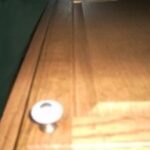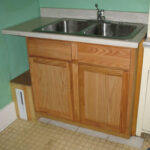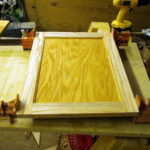Drawers can really expand a cabinet’s storage capacity and to make and install drawers is not an easy task. When closed, drawer contents are protected and out of view; when open, everything inside is easily accessible. Although you can buy ready made drawers in standard sizes from home improvement centers and lumberyards and design the cabinets to fit them, to make and install drawers on your own is a bit more challenging and much cheaper. Here are some techniques to help with this project:
Drawer Selection
Have a clear idea of the kind of drawers you want to make well before you begin the construction. For familiarization, read through all of the following information about drawers:
Appearance – Drawer fronts are cut to fit cabinets the same way doors are. They can completely overlap the edges of a cabinet, partially lip the cabinet and sit flush with the face of the cabinet or inset. Consider the appearance you wish the cabinet to have before choosing the method of cutting and joining.
Cabinet type – Drawers fit box cabinets and face-frame cabinets differently. Before you begin to make a drawer, consider the type of cabinet it will go into and the system of guides that will be used to steer it. The cabinet and guide method will often affect the width of the drawer, its height and its depth.
Construction methods – Choose a design that is strong, won’t eventually fall apart and will work within the limits of your skills and tools.
Choosing the drawer materials
One of the main objects in drawer construction is to make the drawers strong enough to hold its contents but as lightweight as possible. Therefore, the size and amount of materials you use is very critical. Solid pine and fir are excellent for drawer fronts, sides and backs, particularly when you’ll be cutting dadoes and rabbets. But watch out for one thing: large pieces (like 1 by 10s or 1 by 12s) may tend to warp. Unless you can find very straight, kiln-dried wood, choose plywood for deep drawers. A good thickness for a drawer front is three quarters. Making the sides and back from one half inch or five eighths inch material will help keep the weight down, but if you plan to make the drawers with dado grooves into the sides for runners, pick three fourths inch stock. Choose a bottom material that is strong enough to hold the drawer’s contents without bowing–one fourth hardboard is a favorite because it’s smooth, stiff, and does not warp.
How to make the drawers
Although some drawer construction methods call for a cabinetmaker’s skill, anyone can make drawers by following this guide with a minimum of tools and woodworking skill.Regardless of how you make it, every drawer will normally require the same number of cuts (and those made with power tools will need the same number of rabbet grooves and dadoes). Your work time can be shortened by standardizing procedures; repeat the same grooves cuts for several drawers. For example, for drawers of the same size, cut the bottoms all at once. Do the same for sides, fronts and backs. If you dado the bottom in place, cut the dadoes in fronts and sides all at the same time. (A table saw or radial-arm saw is an excellent tool for repeating identical cuts.)
Be sure to cut all pieces exactly and remember to allow 3/32″ between the drawers and the frame, leaving the drawer room to slide. Notice that you can eliminate the need for a drawer stop for flush or recessed drawers by insetting the back and bottom about one half inch into the sides and later trimming the sides to stop the drawers against the back at the proper place.
Using power tools: The dadoes or rabbets required for making this drawer are the reasons you need a power tool.
To make the drawers begin by cutting and grooving all the pieces. Be sure to cut the bottom square at all four corners. Assemble the pieces without glue to check for proper fit; then use glue in all joints for final assembly. First place the drawer front face down on a padded surface and fit the bottom into place. Then fit the side to the front. If possible, drive four nails in dovetail fashion, to hold the pieces together until the glue sets. Otherwise, use clamps when the drawer is assembled. Next, fit the back between the sides, inset about one half inch and nail it through the sides. Turn the drawer upside down and drive several nails through the bottom into the back. Slightly round the top edges of the sides.
Without power tools: If you don’t have the tools necessary for cutting dadoes, this drawer is the one for you. Cut the pieces to size; then check them for proper fit before gluing them together. To make the drawer the bottom must be square at all four corners.
To form the drawer front, brad and glue a three eighths inch or one half inch panel to another three eighths or one half inch panel. Then glue and nail the sides to the inner panel. Or to help keep the drawer’s weight down, you can glue and screw a three fourths inch by three fourths inch block to each side; then glue and screw through each block to the front. Turn the unit on its side after fitting the back in place and glue and nail it to each side. If the drawers won’t be holding heavy items, glue and nail the bottom flush to the lower edge of each side, the back and the inside front panel. Otherwise, nail a one fourth inch by one fourth inch strip around the lower inside perimeter of the sides and front to hold the bottom in place.
To install the drawer guides
Unless a drawer is small enough to slide freely in a box-like enclosure, it must be steered in and out so it won’t bind to install the guides. Two main types of guides perform this job: side guides and center guides. Side guides work for most drawers, holding the weight from each side while steering the drawer. Center guides must be mounted on face frames, for they only guide the drawers (the weight must be supported along a side rail or shelf). Because they require more framing, they waste the space between drawers and are more difficult to install, center guides are recommended only for very wide drawers.
Most guides are a sort of runner-and-groove arrangement. The runner is usually a narrow piece of hardwood. The groove can be a channeled piece of stock, a space between two runners or a groove dadoed into the drawer or cabinet. Manufactured guides cost much more than the homemade variety, but are well worth the money. These roller-and-track systems can give even the heaviest of drawers a smooth ride, allowing them to be fully extended and installed without making special cuts. Manufactured center guides can carry drawers in a face-frame cabinet without additional rails or framing for holding the drawer’s weight. Instructions to install manufactured guides are offered on the packages.
To make wooden guides operate smoothly, first coat them with sealer; then either paint them with shellac and steel-wool them until smooth, wax them or lubricate them with a spray that is made for the purpose.
Side guides carry drawers in either box or face-frame cabinets (block the guides out to meet the drawer in a face-frame cabinet). A side guide is usually a hardwood runner attached to the cabinet that fits in a groove in the drawer’s side. The drawer’s groove should be about one sixteenth inch wider and deeper than the runner (and about half the depth of the drawer’s side material). Be sure the runner is large enough to hold the weight (one half inch by three fourths inch is a popular size). To install the runners, when they are properly located (measure and tack them into position and then try out the fit), mark their placement and fasten them permanently with glue and screws or nails (be sure to countersink fasteners).
Center runners guide wide drawers. Each runner is attached to the cabinet’s face frame and back; extra rails (or a shelf) support the drawer. You can buy a dadoed wooden track, dado it yourself or make a track from two square pieces of stock. Make the guide thin enough to allow the drawer’s bottom to set one half inch up from the sides.
To install, center the guide on the drawer bottom first; then place its mate in the cabinet by measuring from one side. Tack it temporarily, check its workability and then glue and screw or nail it permanently (countersink fasteners).
A dome glide or thumbtack under the drawer’s sides will help it glide smoothly. Unless a drawer is locked into a track, it will require a “kicker” to keep the back end from popping up as you pull the drawer out. The kicker can be a shelf or guide above the drawer, or a wooden bar above the drawer.
After learning these techniques you should be able to make and install drawers on your own more effectively. This guide basically covers everything from choosing from drawer selection, choosing the materials and how to make and install drawers. Have fun creating your own drawers.
Source:
Ernest Joyce (1970). Encyclopedia of Furniture Making. Revised and expanded by Alan Peters (1987). Sterling Publishing. ISBN 0-8069-6440-5 (Original edition), ISBN 0-8069-7142-8 (Paperback)




